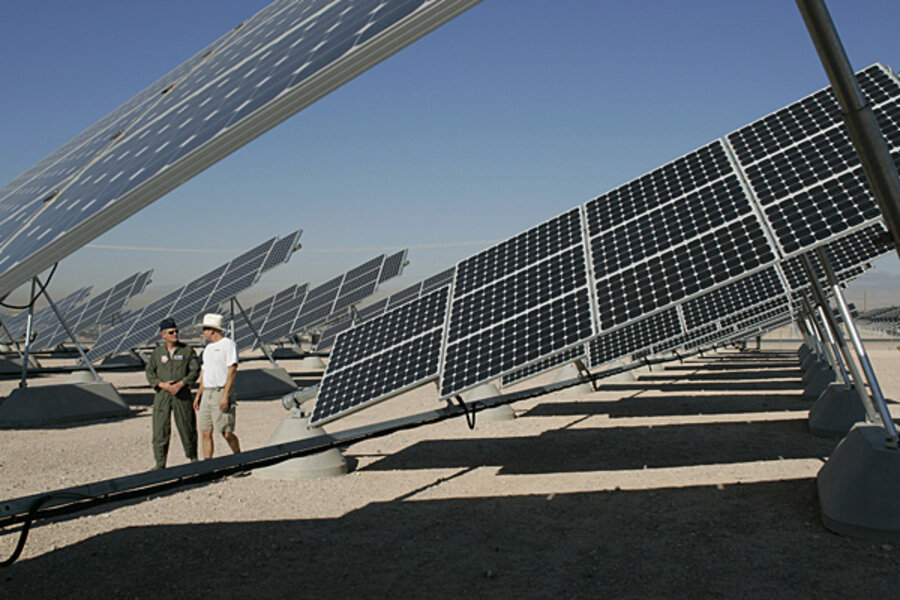Why the US Army is spending billions on clean energy
Loading...
Slowly but surely, the U.S. armed forces are getting serious about renewable energy.
In April 2012, the White House announced the Defense Department was making one of the largest commitments to clean energy in history, by setting a goal to deploy three gigawatts of renewable energy, including solar, wind, biomass or geothermal on Army, Navy and Air Force installations by 2025, enough energy to power 750,000 homes. The Army’s share of the initiative was the energy goal of generating one gigawatt.
Four months later, on 7 August 2012, the Army announced a $7 billion Multiple Award Task Contract (MATOC) Request for Proposal (RFP), designed to assist the Army in procuring reliable, locally generated, renewable and alternative energy through Power Purchase Agreements (PPA) for up to 30 years. (Related Article: Where's the Real Cost of Climate Change?)
Since January 2014 the U.S. Army has added 21 companies to its $7 billion large-scale renewable and alternative energy power production MATOC program, covering work to develop and produce renewable energy for the Army and Defense Department. According to the Army Corps of Engineers, 79 contractors are now involved in the three decade program, with those selected competing for task orders to provide renewable energy by owning, operating and maintaining the energy assets.
Army Corps of Engineers Huntsville Center commander Col. Robert Ruch said, “We are adding these additional companies to those already in the technology pools to ensure we have enough pre-qualified companies ready to submit proposals on task orders as they come up. Huntsville Center is doing everything we can to ensure task orders for future projects will be awarded as quickly as possible.”
The program’s renewable energy mandate is very broad; 38 companies are competing for work in the program’s solar technology area, 20 in wind, 15 in biomass and six in geothermal and the new round of selections includes 15 for solar, three for wind and two for biomass. The second round of MATOC awards follows the original August 2012 Request For Proposal (RFP) which allowed for immediate awards to firms within the competitive range and additional awards to firms that after further government evaluation qualified.
The selected MATOC companies will be eligible to bid on future renewable energy task orders. As renewable energy opportunities at Army installations are assessed and validated, Huntsville Center will issue a competitive task order Request for Proposal to the pre-qualified MATOC companies for the specific technologies. Best of all for the Pentagon’s bottom line, MATOC involves third-party financedrenewable energy acquisitions and do not utilize any Army or Department of Defense capital, or Military Construction appropriation. Instead, the Army or DOD will purchase the renewable power from the MATOC contractors who own, operate and maintain the generating assets through power purchase agreements (PPA). The MATOC's total estimated value of $7 billion capacity refers to the total dollar value of energy available for purchase under all PPA task orders for their entire term of up to 30 years. (Related Article: Lockheed Martin to Build World’s Largest Wave Power Facility in Australia)
Not that the U.S. Army has suddenly embraced the environmental benefits of renewable energy. The MATOC contracts will support the Army's goal of fulfilling its congressionally mandated energy goal of generating one gigawatt, 25 percent of its energy requirements, from renewable sources by 2025 while improving installation energy security and sustainability.
The implementation of the MATOC program dates back to 3 May 2013, when the U.S. Army Corps of Engineers, Engineering and Support Center, Huntsville, working with the Army Energy Initiatives Task Force (EITF), awarded the first Indefinite Delivery Indefinite Quantity (IDIQ) MATOC contracts for the first technology to support renewable energy on Defense Department installations. Individual MATOC awards were being staggered by technology, with the first announcement being for geothermal proposals. The five companies awarded contracts for use in competing and awarding PPA task orders using geothermal technology were Constellation NewEnergy, Inc., Baltimore, Md.; ECC Renewables, LLC, Burlingame, Calif.; Enel Green Power North America, Inc., Andover, Mass.; LTC Federal, LLC, Detroit, Mich. and Siemens Government Technologies, Inc., Arlington, Va. The announcement of awards for solar, wind and biomass technologies were staggered through the end of 2013.
The Army has made some impressive commitments to renewable energy – it will be interesting to see if they fulfill their mandates by 2025.







